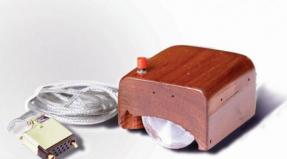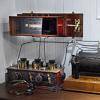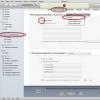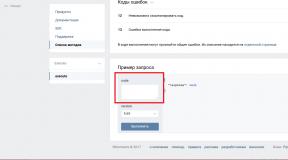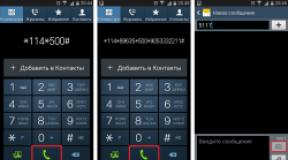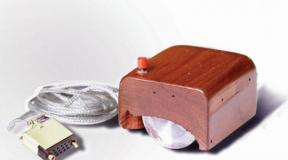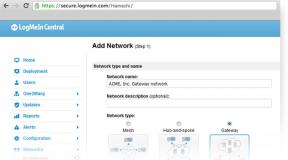Installing Windows via UEFI BIOS. How to configure the BIOS to boot from a disk or flash drive New BIOS installation of Windows 7
More and more modern motherboards are built based on UEFI BIOS with support for the GPT partition style. The advantages of such a system seem to be obvious - faster loading, support for large storage devices, higher reliability and security. However, using a GPT disk is not suitable in every case. For example, if you need to install a 32-bit version of Windows. Also, if you are still not ready to take out a mortgage to purchase a Windows 7 license, then activating it using the usual means will be, if not impossible, then extremely difficult. Installing Windows 7 on a system with a motherboard running UEFI BIOS using the good old MBR will be discussed in this post.
The first step is to prepare an installation disk with Windows 7, or, if your computer does not have a disk drive, a bootable installation flash drive. For this I use the WinToFlash program.
The motherboard in my case was ASUS A88XM-A. Via F2 we go to the UEFI BIOS:

Switch to Advanced Mode:

And go to the tab BOOT where in the graph USB SUPPORT we exhibit FULL INITIALIZATION:


Going into it we set the following - Launch CSM - Enabled :

And in the column Boot Device Control - Legacy OpROM Only. Although, perhaps everything will work with UEFI and Legacy OpROM, I'm not sure and haven't checked.


And at the point OS TYPE choose OTHER OS:

Then we save the changes and exit the UEFI BIOS, booting from our installation media.
We go through the usual starting points of installation. If the disk was with the MBR partition style, then the installation should go without problems. If the disk has already been converted to GPT style, then it is necessary to convert it to MBR.
WARNING: During this operation, all data on all hard drive partitions will be destroyed!
This is done like this:
When you reach a screen that asks you to select a drive to install Windows, for example, this:

Press the key combination SHIFT-F10 to go to the command line.
1. Enter the command diskpart
2. list disk— see a list of disks available in the system
3. select disk N- where N is the number of the disk that we are going to convert.
4. clean— complete disk cleanup with partition removal.
5. convert mbr— converting the disk to MBR.
Now on the partition selection screen, click “Update” and create partitions through “Configure Disk”.
Recently, many motherboards, instead of the usual bios firmware, have an improved version called uefi. The program interface supports language selection, allows the use of new types of hard drives with a capacity greater than 2 TB, and contains other improvements. If you have the latest uefi bios firmware installed on your computer, then we will tell you how to install windows 7 in a few steps.
Advantages of uefi firmware over bios program
The advantage of uefi firmware is its extremely effective acceleration of loading of your operating system. In addition, uefi bios makes it easier to restore information, install updates, and have other advantages. Experienced users understand the difference between MBR and GPT disks, but you may want to keep your head down. Just remember that uefi is the real near future, and bios is obsolete.
An unpleasant feature of the uefi firmware
The saddest feature of this program is the inability to migrate from an installed Windows 8 operating system to a new computer. So if you have 8 pre-installed, then you won’t be able to install 7 so easily. This is due to the presence of a mandatory protocol that Microsoft now requires from all licensed versions of Windows - loading Secure Boot, which is absent in Windows 7 and is not provided in previously released versions of the OS. This can be solved by disabling this option in the program menu. Go to the Security section, disable Secure Boot.

Don't forget to turn on compatibility mode! The route is as follows: Advanced tab - System configuration - Boot Mod (maybe OS Mode Selection).

We set the found option as follows: change UEFI OS (or UEFI BOOT) to “CSM Boot” or “UEFI and Legacy OS”, “CMS OS”.

Before you begin, you either need to create a bootable USB flash drive yourself or have a licensed installation disk with this system. We recommend that owners of distribution kits start reinstalling immediately, because the method of how to work with a bootable USB flash drive is described below in the instructions. The installation disk will not cause any problems.
Now let's configure uefi for installation from a flash drive.

UEFI BIOS has made a lot of noise in the digital world, and since all new computers and laptops already have this interface installed, we received a whole bag of letters regarding this topic in the mail. Questions are primarily of this nature.
What is UEFI BIOS and why did it replace the regular BIOS? Why can only Windows 8 be installed on a laptop with a UEFI BIOS, and no other operating system or even another operating system can be installed, then how to do this?
Why on a laptop with BIOS UEFI Is it possible to install Windows 8 of a different edition?
BIOS UEFI
After reading all the letters, I decided to answer them with one article and in such a way that everything would be clear even to a novice user.
An important incentive for writing this article was the fact that, according to my observations, a lot of people who buy new computers with an SSD drive and a motherboard that supports the new UEFI interface immediately disable this interface and install Windows 8 on a hard drive with an outdated master boot record. MBR.
What was the point then of buying a new expensive computer for 30-40 thousand rubles with an SSD drive and a UEFI BIOS, which undoubtedly gives advantages over a simple BIOS. You ask - What are the benefits? This is what I want to talk to you about.
BIOS UEFI (Unified Extensible Firmware Interface) is an interface between the operating system and firmware that controls low-level hardware functions. Developed by Intel. The history of the creation of the UEFI interface dates back to the first half of the 90s and at first it was called the Intel Boot Initiative, later it was given a different name EFI. The first EFI 1.02 specification was released by Intel in 2000.We all know what a BIOS is, yes, that’s right, it is a “basic input/output system”, and in human terms it is a microprogram built into a simple chip, which in turn is located on the motherboard. So, this firmware (BIOS) is an intermediary between the installed operating system and the components installed on the computer. That is, the BIOS explains to the operating system how all computer components can be functionally used: motherboard, processor, video card, RAM, and so on. The BIOS starts before the operating system and immediately checks (POST procedure) all the computer hardware listed above: processor, motherboard and everything else, setting the necessary parameters for their operation. If any component malfunctions, the BIOS emits a signal through the built-in speaker, by the nature of which you can understand which device is faulty.
In short, BIOS turns out to be a rather important thing on a computer, but... today, friends, BIOS has been replaced by a much more advanced tool called UEFI.
What's wrong with a regular BIOS?
Here are the most important reasons.
1) When you turn on the computer, the BIOS, in addition to checking the components for serviceability, checks all hard drives for the MBR (master boot record), which is located in the zero sector and has a size of 512 bytes; when a boot record is found, the BIOS starts the boot record the code is in the MBR, then the operating system is loaded. On a computer with a regular BIOS and a hard drive (having an MBR (Master Boot Record)), volume addressing is done in such a way that the maximum addressable space on the hard drive can be a maximum of 2TB, that is, the operating system will NOT see more than 2TB of disk space on a 3TB hard drive, which you will agree is not very convenient given the current capacity of hard drives.
2) On computers with a regular BIOS, hard drives (having a master boot record MBR) have a limitation on the creation of primary partitions, that is, only 4 primary partitions can be created on an MBR disk - three main and one additional partition in which logical disks can be created, You can install an operating system on the logical one, but it will not start without a boot manager on the main partition). And UEFI BIOS works with hard drives that have a GUID partition table (GPT), such hard drives can be divided into 128 primary partitions.
3) And most importantly, UEFI BIOS is much safer. It is no secret that there has long been a rootkit capable of injecting its code into the BIOS chip and loading itself before the operating system, thereby gaining unlimited control of the system itself. This is not possible in UEFI BIOS; it has a secure boot procedure “Secure Boot”,

Based on special certified keys from Microsoft. Looking ahead, I will say that because of this very secure boot, ordinary users cannot install anything other than Windows 8 on computers with UEFI BIOS, since only Windows 8 today has these same certified keys (further in the article there is more complete information about this ).
Advantages of UEFI BIOS

So, let's take a look at the new UEFI BIOS one by one and find out its main advantages over a regular BIOS. The UEFI interface is a mini operating system, or in other words, an improved and completely redesigned mechanism that will soon completely replace BIOS. Firstly, UEFI took a lot from its predecessor and is intended primarily for the interconnection of the operating system and the hardware installed on the computer, that is, all the components of the computer. When you turn on the computer, the UEFI interface must test all equipment for serviceability and then pass the baton to the operating system bootloader.
1) BIOS UEFI has its own very convenient and intuitive graphical control interface with mouse support. There is support for the Russian language.
2) UEFI BIOS works with hard drives that have a GUID partition table (GPT), such hard drives can be divided into 128 primary partitions (by the way, only 4 primary partitions can be created on an MBR disk - three main and one additional partition in which logical drives can be created , you can install an operating system on the logical one, but it will not start without a boot manager on the main partition).
3) UEFI BIOS makes it possible to use hard drives with a capacity of more than 2 TB, the maximum partition size can reach 18 exabytes (18,000,000 terabytes). On a computer with a regular BIOS, the installed operating system will NOT see more than 2.2 TB of disk space, which is of course inconvenient.
4) Hard drives with a GUID partition table (GPT) work only with LBA addressing, unlike MBR hard drives working with outdated CHS addressing.
6) GUID (GPT) hard drives make it easier to recover lost data.
7) BIOS UEFI has its own boot manager, which is very convenient to use if there are many operating systems on the computer; there is no need to use special bootloaders like EasyBCD.
8) UEFI BIOS is much easier to update than a simple BIOS.
9) GPT is more secure than MBR because the partition table is written at the beginning and end of the disk, providing duplication.
Secure Boot protocol
But the most important feature of the UEFI mechanism, which causes trouble for users, happens when reinstalling Windows 8 on a new computer or laptop. The UEFI BIOS has such a secure boot protocol “Secure Boot”, based on special certified keys which only Windows 8 from Microsoft has and Microsoft requires all manufacturers of computers and laptops with Windows 8 pre-installed to be enabled by default secure boot protocol "Secure Boot".
Having such keys in its distribution, Windows 8, when installed on a computer from any manufacturer, successfully passes the UEFI “Secure Boot” protocol, but none of the older Windows operating systems, as well as Ubuntu or Linux distributions, have such keys. That’s why, if your laptop has a UEFI BIOS, then you won’t be able to install any other operating system on such a laptop, there’s only one way out,

but then you will install the operating system you need on an MBR disk and will lose all the advantages of working with a hard disk with a GUID (GPT) style.
Of course, many users will think that in this way Microsoft is getting rid of competitors, but Microsoft successfully fends off such attacks by explaining that the UEFI interface with all its protocols and secure boot"Secure Boot" designed primarily for our safety and it’s hard to disagree with it (I already talked about a rootkit that can write its code into a regular BIOS at the beginning of the article).
Attentive readers may ask why Linux doesn’t come to an agreement with Microsoft and computer manufacturers and get these same keys. I found the answer in the blog of one of the Linux kernel developers - Matthew Garrett,
Matthew Garrett

It turns out that this is difficult both physically (this will take a lot of time, since you first need to agree with Microsoft, then you will have to negotiate with each computer manufacturer separately) and legally (the problems are related to the GRUB 2 bootloader, licensed under the GPLv3 license).
Many readers are interested in whether it is possible to make a bootable UEFI USB flash drive with the Windows 7 operating system?
You can make a bootable USB flash drive (we have an article about this), but you won’t be able to install Windows 7 on a laptop that previously had Windows 8 installed; it simply won’t pass one of the “Secure Boot” security boot verification protocols.
I will say more, even if you want to reinstall Windows 8 on your laptop, you will only be able to do this with the edition of Windows 8 that was previously installed on your laptop. Typically, manufacturers install Windows 8 on laptops for one language (Windows 8 Single Language), so you can only reinstall Windows 8 if you get an installation disk with Windows 8 Single Language.
And you simply won’t be able to install Windows 8.1 Professional on your laptop, for example, on many laptops; during installation you will receive the error “The entered product key does not match any of the Windows images.”
Note: If you want to change the version of Windows 8, that is, reinstall the Windows 8 Single Language installed on your laptop (for one language), for example, to Windows 8 Professional, this can also be done, but with laptops from some manufacturers this simply will not work and you need to will change additional configuration files that can be used during the Windows installation process to specify the product key and edition of Windows, details in our article ""
At the end of the article, I want to say that it is possible to install another operating system, for example Windows 7, on a new laptop instead of Windows 8, but as I already said, in the UEFI BIOS we will have to disable the secure boot protocol “Secure Boot”, how to do this, you can read in our article "How to install Windows 7 on a new laptop instead of Windows 8."
If you have a simple desktop computer, then you can install Windows 7 without disabling the “Secure Boot” option in the UEFI BIOS; also read the detailed article “How to install Windows 7 on a GPT disk.”
Read the following article: How to disable Secure Boot.
Articles on this topic.
Windows 7 has been very popular since its release. Subsequent versions of the operating system from Microsoft were met with mixed reactions by users, and this is especially true for the eighth edition. Although the “ten” still has a fairly large number of fans, many want to know how to install Windows 7. This is not as complicated a process as it might seem, and most users will be able to install this OS on their computer or laptop themselves.
Preparatory stage
Every PC owner should remember that the OS can be completely reinstalled or the existing one can be updated. If your computer is unstable, then you should choose the first option. Since this process involves formatting the system disk, it is necessary to transfer all important files from it to another partition. Otherwise they will be destroyed.
To install Windows, you must have a boot disk or flash drive. The user must also understand what operating system bit depth should be installed. This is quite simple to determine - if the PC has 4 GB or more of RAM installed, then Windows 7 64-bit is selected. When there is less RAM, then you should opt for the 32-bit edition.
In addition, you should make sure that all the necessary drivers are available. If the OS will be installed on a laptop, then they should first be downloaded from the manufacturer’s website. When purchasing a desktop PC, discs are included with the motherboard and video adapter. They contain all the drivers necessary for the normal operation of the computer.
It remains to decide which version of the operating system will be installed. Total company Microsoft offers six editions of this OS:
 After carrying out the preparatory activities, you can answer the question of how to install Windows 7 yourself from the Internet. We should immediately warn you that this OS does not support USB 3.0 ports. To be able to distinguish the standard from earlier ones, they are painted blue. If the installation will be carried out from a flash drive, then it must be inserted into USB 2.0. It is also worth remembering that new PCs are equipped with a UEFI BIOS and the process of installing an operating system on them has some features.
After carrying out the preparatory activities, you can answer the question of how to install Windows 7 yourself from the Internet. We should immediately warn you that this OS does not support USB 3.0 ports. To be able to distinguish the standard from earlier ones, they are painted blue. If the installation will be carried out from a flash drive, then it must be inserted into USB 2.0. It is also worth remembering that new PCs are equipped with a UEFI BIOS and the process of installing an operating system on them has some features.
Computers with old BIOS
If the BIOS supports the Boot Menu, then after rebooting the PC you need to call it. To do this, one of the keys is most often used - F8, F2, Esc, F11. In the window that appears, select the desired device.
However, this method is not suitable for all computers, and in such a situation it is necessary to change the boot priority in the BIOS manually. To do this, you need to restart the PC and press the Del key when the logo appears. Some motherboards and laptops use different buttons.
Actions after entering the BIOS depend on its version:
- Phoenix-Award - the “Advanced BIOS Features” section is selected, and in it there is the line “Hard Disk Boot Priority” or “First Boot Device”. Then use the arrows to select the desired device, for example, USB-HDD for a flash drive.
- AMI - on the top panel you need to find the “Boot” tab and go to the “Boot Device Priority” section. Having entered the line “1st boot”, press “Enter”, and then use the arrows to select the desired device.
After completing these steps, you will need to save the settings and restart your PC. If everything was done correctly, the OS installer will start loading. The further sequence of actions looks like this:

After this, a window for selecting HDD partitions appears, and the user is faced with the question of which disk to install Windows 7 on. The first is intended for storing system backups and has a size of about 100 MB. The second one should be selected and it must be formatted before installing win 7. To do this, follow these steps::
- Click on the “Disk Settings” line.
- Having selected the desired partition, press the “Format” button, and then “OK” to confirm the operation.
When the formatting process is complete, you need to select the partition again and click on the “Next” button. After this, you can wait 20 minutes for the installation process to complete, and the PC will automatically reboot several times. After installing the operating system, you need to select system operating parameters and install drivers.
Machines with UEFI BIOS
And now about how to install Windows 7 on new PCs yourself. Login to UEFI is done using F2 or Del. Then you need to go to the “Boot” section and change the “Secure Boot” value to “Disable”. As a result, a new item should appear - “OS Mode Selection”. In it you should select “UEFI and Legacy OSТ” and save the changes made by pressing the F10 key.
 The PC will begin to reboot, and at this moment you need to log into UEFI again. Then, in the “Boot Device Priority” menu, select the desired boot device. If you previously installed “eight” or “ten” on your computer, then some problems may arise. This is because recent versions of Windows format the hard drive using the GPT partition table standard rather than MBR. For the “seven” to work, the second format is required. To solve the problem, you will have to use a step-by-step guide.
The PC will begin to reboot, and at this moment you need to log into UEFI again. Then, in the “Boot Device Priority” menu, select the desired boot device. If you previously installed “eight” or “ten” on your computer, then some problems may arise. This is because recent versions of Windows format the hard drive using the GPT partition table standard rather than MBR. For the “seven” to work, the second format is required. To solve the problem, you will have to use a step-by-step guide.
In this case, you should select the disk where the user wants to place the OS, then set the OS language and click on “Full system installation”. The next step is to open the command line using the keyboard shortcut “Shift + F10”. After her appearance the required order of entering commands is as follows:
- diskpart;
- seldis 0;
- clean;
- convert gpt;
- exit;
- exit.
After clicking the "Update" button, the installation can continue. Upon completion of the process, you need to set the system operating parameters and install drivers.
Don’t be afraid to install the OS yourself, because this is not the most complicated process and you don’t have to pay money to a specialist to do it.
The massive transition to UEFI (Unified Extensible Firmware Interface) has already begun. Microsoft requires this interface to be used on all computers that will ship with Windows 8. More precisely, we are talking about UEFI with the Secure Boot feature. At the same time, only “eight” can work on such PCs without problems: neither Windows XP nor “seven” can be installed on a UEFI machine without additional manipulations. You won't be able to boot from a Linux Live or Windows flash drive either. What exactly can happen if you try to start from the installation flash drive on a Sony VAIO laptop is shown in the picture above. And the problems with UEFI don't end there. Each hardware manufacturer configures UEFI at its own discretion, thereby creating unnecessary difficulties for the user. The IdeaPad laptop from Lenovo was not able to recognize the same flash drive as boot media at all. At the same time, Lenovo has nothing to blame: the fact is that the bootable flash drive is formatted in the NTFS file system, and UEFI does not support booting from such media. If you connect the same drive to an EliteBook laptop from HP, it will boot without problems and allow you to install Windows. The problem is that all the data on the EliteBook disk would be deleted after installation.
Everyone configures differently
Are you confused? No wonder: UEFI with Secure Boot establishes new rules for installing and booting operating systems, and hardware manufacturers interpret these rules in their own way, which creates additional difficulties for the user. Therefore, in this article, we set ourselves the goal of clearing up the confusion around UEFI. Using laptops from major manufacturers as an example, we will tell you how UEFI works, what role the Secure Boot function plays, how to bypass the “traps” set by the new interface, and what you need to use bootable flash drives without fear of any destructive consequences.
How UEFI works
UEFI boots strictly according to established rules. If the OS does not support UEFI, BIOS emulation mode is activated. The process of booting a BIOS-based PC is quite simple: after pressing the power button, the BIOS starts, which checks the status of the hardware and loads the firmware - simple drivers for individual hardware components. The BIOS then searches for the OS bootloader and activates it. This in turn loads the operating system or displays a list of available operating systems.
UEFI-based computers boot in a similar way only until the boot options are searched. After this, everything happens differently. UEFI has its own OS bootloader with integrated launch managers for installed systems. For it, a small partition (100–250 MB) is created on the disk, formatted in the FAT32 file system, which is called Extensible Firmware Interface System Partition (ESP system partition). It contains drivers for hardware components that can be accessed by the running operating system. The general rule is that, with the exception of DVDs, UEFI can only boot from media formatted with the FAT32 file system.
UEFI is a complex mechanism
ESP has its advantages: thanks to UEFI drivers and the OS loader, Windows starts faster and responds more adequately to critical driver errors. But the UEFI interface also imposes restrictions: it allows you to install the OS only on hard drives that are marked according to the GPT standard. The latter is not supported by any BIOS version, since, unlike the traditional partitioning scheme (MBR), it uses 64-bit sector addresses. In addition to Windows 8, the UEFI interface is supported only by 64-bit versions of Windows Vista and 7, as well as Linux with kernel 3.2 and higher. Moreover, for PCs certified to work with G8, Microsoft requires the use of the Secure Boot option. In this mode, UEFI only launches verified OS boot loaders that contain Microsoft digitally signed drivers.
Along with Windows 8, only the Shim bootloader (Linux) has drivers with the necessary signatures for Secure Boot. They are not available in other OSes. Therefore, if you want to install Windows 7 or Vista on such a computer, in addition to G8, you need to open the UEFI menu and disable Secure Boot. If you choose a non-UEFI compatible OS as your second OS, you will need to use the Compatibility Support Module (CSM), which can be enabled in UEFI. Unfortunately, manufacturers use different versions of UEFI, and it can sometimes be difficult to figure out how to disable Secure Boot and enter BIOS emulation mode. We will consider these questions further.
UEFI based PC boot process
Depending on the configuration, UEFI either boots the computer itself or goes into emulation mode of the standard BIOS. Only after this does the Windows Boot Manager start.
Installing Windows on a PC with UEFI and Secure Boot
On a PC with Windows 8 based on UEFI Secure Boot, other versions of the OS can be installed only under certain conditions. The user must select the correct boot mode in advance and prepare the installation flash drive accordingly.

Enabling BIOS emulation mode
Complete confusion: the method for entering BIOS emulation mode depends on the UEFI version. On Sony VAIO (1) you need to activate the “Legasy” option, on ASUS Zenbook (2) - “Launch CSM”.

UEFI setup
Each manufacturer uses its own version of UEFI in laptops and ultrabooks. However, it does not provide access to all the necessary functions. Often, when loading a PC or laptop, the display does not display the name of the button that can be used to open the UEFI settings menu. We suggest doing the following: in the Metro interface, go to the “Options | Change PC settings" in the sidebar and activate the "General | Special download options." After the restart, the OS boot manager will appear, which will allow you to open the UEFI menu. The exception is HP's UEFI, which does not have this option. The following will help: while loading, hold down the "Esc" key. In any case, you must first find out which button allows you to enter the UEFI menu. If you change the boot mode to CSM or Legasy BIOS to boot from a rescue flash drive, you must switch back from CSM to UEFI after the recovery operation, otherwise Windows 8 will not start. But there are exceptions here: Aptio Setup Utility on ASUS computers activates UEFI automatically in the absence of BIOS-compatible bootable media, so you just need to disconnect the flash drive.
Disabling Secure Boot will be required if, in addition to G8, you want to install a 64-bit version of Windows Vista or 7. Sometimes the so-called hybrid mode is supported, as in devices from HP, in which UEFI can boot from all bootable media and, if necessary, switch to BIOS mode. In the widely used UEFI version InsydeH2O, this depends on whether the laptop manufacturer has provided the ability to disable Secure Boot or not. In the Acer Aspire S7, this function is not available, and to deactivate it you need to switch from UEFI to BIOS mode and back.
Difficulties with recovery
With the advent of UEFI, manufacturers changed the way they work with the OS recovery system. The “Alt+F10” keyboard shortcut, which was previously used, for example, in Acer models, no longer works or is assigned to other functions. And the “F9” button loads on the new Zenbook not the ASUS Preload Wizard, but the Windows 8 recovery program with an extended boot menu.
The VAIO Care recovery mode in Sony laptops can be opened in a similar menu by selecting the “Control Panel | Troubleshooting | Recovery". But if you start the OS boot manager and select “Diagnostics | Restore" or "Restore to original state", the device will ask you to insert the original Windows 8 disc, which is not included in the package. On Acer models, backup is performed using a pre-installed Windows program, and restoration from a backup is carried out from an external USB drive. However, you must first go to the UEFI menu and specify such a disk as a boot one.
Going to the UEFI menu from Windows
If Windows 8 Advanced Startup is enabled, you can access the UEFI Firmware Options menu (3) by selecting Diagnostics (1) and Advanced Options (2).

Useful UEFI Features
Each laptop manufacturer uses different versions of the UEFI interface and implements it in the system in accordance with their ideas. The table, broken down by model, will show you where the main UEFI features are located.

Solving the problem: disabling Secure Boot
In some cases, Secure Boot cannot be deactivated directly. In Acer Aspire S7, for example, this function is not available. But if you switch to “Legacy BIOS” (1) and back again (2), Secure Boot will be disabled.

In hybrid mode, everything is possible
HP's version of the UEFI interface supports hybrid mode, in which, depending on the boot media, one of two modes is launched - either UEFI or CSM. In this case, the Secure Boot function is disabled automatically.

Run from a flash drive
Older flash media for emergency boot and recovery only work in BIOS mode. We will make them UEFI compatible.
USB flash drives have recently become increasingly used as bootable media for restoring or installing Windows. This is due to the fact that modern laptops very rarely have optical drives installed. If you have examined the UEFI settings on your computer, it is recommended that you also upgrade your flash drives. With the advent of UEFI, all existing bootable flash drives can no longer be used in the usual way. For example, if you created a bootable USB media using UNetbootin, you will need to start your PC in CSM mode. The same applies to all old flash drives, since the developers of Linux Live distributions (for example, GParted) only began to add a bootloader with UEFI support and Secure Boot functions in the latest, most recent versions of their applications.
The simplest method is to disable Secure Boot in UEFI, then use the free Rufus program to create a UEFI-compatible flash drive, and then copy the latest version of GParted to it.
The Microsoft program is outdated
For bootable USB drives running the Windows operating system, slightly different rules apply. To be UEFI compatible, they must be formatted with the FAT32 file system. Many users, even for Windows 8, create bootable drives on flash drives formatted using a program from Microsoft, part of the “seven”. However, this application formats the drive with the NTFS file system by default, making the system on the drive subsequently impossible to install on a computer with UEFI. To avoid waiting for an updated program from Microsoft, you can create a bootable drive manually. To do this, first format the USB flash drive using a free utility. Then open the ISO image in Windows 8 and copy the files it contains to the media.
But in order for a UEFI-compatible flash drive with 64-bit Windows 7 to boot without any problems, you will need to copy the UEFI boot loader to the desired directory on the flash drive. To do this, using the free 7-Zip archiver, find the Install.wim archive file in the ISO image that contains the Windows 7 installation files in the Sources folder and open it. After that, copy the bootmgfw.efi file from the 1\Windows\Boot\EFI directory. Then save it to your flash drive in the efi\boot directory and rename it bootx64.efi. After this, you can work with the USB drive in UEFI mode, and you will be able to install Windows 7 from it without any problems.
Creating bootable flash drives based on Live systems
To be compatible with UEFI, flash drives must be formatted in FAT32. For example, the UNetbootin (1) program creates bootable drives based on Linux Live distributions, formatting them in FAT. However, the Rufus utility (2) offers a more correct option.

Flash drive for OS recovery on PC with UEFI
Flash drives based on recent Live systems, such as GParted, can easily access UEFI PCs, since their built-in tools - such as GPart (1) and TestDisk (2) - can work with GPT partitions.

Formatting a bootable USB flash drive with Windows
The 64-bit version of Windows 7 can also be installed on a PC with UEFI. If you want to perform this operation from a USB drive, you need to format it using the Windows DiskPart program as a FAT32 file system and make it bootable.

Removing the UEFI Boot Loader
A UEFI-compatible flash drive running Windows 7 additionally requires a UEFI boot loader - bootmgfw.efi. It must be manually copied from the install.wim archive to a flash drive using 7-Zip or any other archiver.

Source


